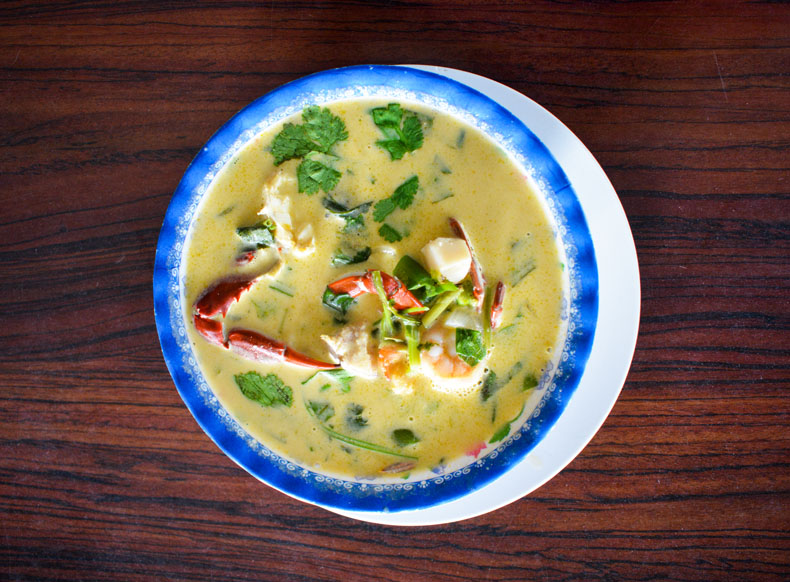In the heart of Central America, Honduras is an incredibly diverse country with a unique gastronomy reflecting indigenous Mesoamerican, Spanish, African, and Caribbean influence. In different parts of the country you’ll encounter distinctive customs, traditions, and of course foods contributed by these various cultures. Not surprisingly, getting to know typical Honduran dishes is the easiest way to dip into Honduran culture and history.
Like some of the country’s Central American neighbors, the staple ingredients of Honduran cuisine include corn, beans, tomatoes, salty cheese, a grilled meats (chicken, pork, beef) and seafood. Avocado often accompanies the latter dishes. Tropical fruits like plantain and coconut are used a lot too. Not a day goes by in Honduras without eating corn tortillas and tajadas, the sliced and fried green plantains that are an obligatory part of any lunch.
Making tortillas in Honduras. All photos courtesy of Joanna Nowak.
While Honduran cuisine isn’t heavy on condiments, the vinegar-based hot sauce known as “chile” is offered everywhere—more often than salt or pepper, even. It’s there to add some spice to traditionally mild dishes. Chimol, a mix of tomatoes, onions, chilies, lime, and cilantro that’s similar to pico de gallo, is an essential accompaniment to many dishes too.
Tortillas, made and consumed since the time of the Mayans, are a pillar of Honduran cuisine, culture, and history. Women selling handmade tortillas can be seen everywhere in this country. Tortillas in Honduras are made with both corn and wheat flour. They’re folded, pan-fried, deep-fried, or served on the side in countless Honduran dishes, including some of those examined here.
Generally speaking, the Mesoamerican food can be found in the ragged west of Honduras, and the Caribbean and African flavors in the east. Plenty of dishes, the real popular Honduran foods, are very widespread, found pretty much everywhere. But others are true regional specialties, and unlikely to be found in parts of the country beyond where they originate.
To reflect this, our list of favorite traditional Honduran dishes and drinks includes both the super popular and the hyper regional. Here are 8 typical Honduran foods you shouldn’t miss.

Baleada
Let’s start with the most Honduran dish of all: the baleada. Probably the most famous Honduran food, baleadas are folded wheat-flour tortillas filled with fried and mashed red beans, grated or crumbled white cheese, and mantequilla—which is not “butter,” as per the translation, but Honduran-style sour cream. This comprises a baleada sencilla, the simplest version of this meal.
But the fillings don’t end there, not by a long shot. Baleada mixta includes those three ingredients plus scrambled eggs, and a “super preparada baleada” will have meat and avocado slices. Always made to order, baleadas are generally eaten only for breakfast or as a late-night snack.
Where to find it: It’s more a question of when, not where, as baleadas are a popular street food found on nearly every corner! But they’re served only in the morning and after sunset, so don’t expect a baleada for lunch. You will see vendors selling baleadas in plazas, markets, near malls, and on the side of the street almost everywhere in Honduras.
For the biggest baleadas in Honduras, head to Baleadas Kike in San Pedro Sula (map), in the north, or Plaza Tipica (map) near the main square. If you land in Tegucigalpa, head to Comedor Blanquita in Mercado Los Dolores (map), where you can eat your first baleada among locals.

A plato tipico, or typical plate, for lunch in Honduras.
Plato Tipico (Almuerzo y Cena)
Plato tipico means, simply, “typical dish,” and there will be lunch (almuerzo) and dinner (cena) plates offered at many local eateries. It’s essentially always going to be the same, though regional differences exist. The most traditional Honduran almuerzo and cena revolves around the grilled meat of your choice—chicken, pork, or beef—alongside refried beans, white cheese, tajadas (fried plantains), rice, some avocado, and tortillas. This will also be complemented by that salsa-like chimol. In the Caribbean areas of Honduras, this typical lunch or dinner will most likely shift to include coconut and seafood such as fresh fish, shrimp, or lobster.
Where to find it: This is found in all typical, casual Honduran eateries all over the country. Local markets are the best places to try traditional foods for a low price and a great atmosphere. For especially good platos tipicos in Honduras, head to Sabor Del Campo (map), which uses an especially tasty sauce on its tajadas, or Restaurante La Orquidea (map), both in Peña Blanca.

Honduras pastelitos with the requisite cabbage on the side
Pastelitos Hondureños
Honduran pastelitos are empanada lookalikes, made with a dough of corn flour, achiote (a typical Mayan ingredient; see Coastal Yucatán cuisine as well), onion, garlic, and sometimes potatoes or rice that’s cooked, then blended and rolled flat. Filled with any type of meat or vegetable, they are then folded, pinched together, and fried. For serving, pastelitos are topped with red onion, shredded cabbage, and hot sauce, if desired. What makes these unique is the shredded cabbage on the side—without that, they’re not considered pastelitos.
In Tegucigalpa, where this dish originated, these are also known as pastelitos de perro (dog’s cake), as the ingredients that comprise them are the same used to give dogs lunch leftovers. (Yes, those are well-fed perros!)
Where to find it: Pastelitos are available in most Honduran eateries. For a good restaurant, head to Casa Tipica in Santa Rosa de Copán (map), or try them in their birthplace Tegucigalpa, at ¡Quiero Pastelitos! or Los Tonelitos (map).

Catrachas
Catrachas are fried corn tortillas spread with some of the most beloved Honduran ingredients: refried beans, crumbly white cheese, and chimol. These can be topped with other ingredients as well, such as mantequilla, hot sauce, avocado, or even meat.
Catracho/a also refers to a Honduran person. This dish is as typical as one can get!
Where to find it: A very common street food, catrachas can easily be found in most traditional eateries in Honduras, especially in the west. One of the best places to try one is from the street vendors in Central Plaza of La Esperanza, Intibucá (map).

Tortillas de quesillo
Tortillas de Quesillo
Like a Honduran grilled cheese, tortillas de quesillo are made by frying a tortilla and topping it with cheese and another tortilla. It is then all deep-fried together until melty and browned. These are served with more grated cheese, chimol, mantequilla, or hot sauce.
Like other Honduran tortilla dishes, these are supposed to be eaten with your hands, so do not be surprised if your dish isn’t accompanied by cutlery!
Where to find it: This is another very common dish, found nearly everywhere in Honduras: at bus terminals, in local markets, on the side of the street, in restaurants. Look for tortillas de quesillo in Mercado de Los Dolores in Tegucigalpa (map); for a restaurant take on this, try De La Finca Angus (map).

Sopa de caracol, or sea snail, is a traditional coastal Honduran dish.
Sopa de Caracol
Having soup on Sundays is customary for Honduran families. And one of the most popular is sopa de caracol, a conch soup that originated on the country’s north coast, where Caribbean flavors dominate. This soup and other traditional dishes in this region reflect the culture of the Garifuna people, who have mixed African and indigenous Caribbean ancestry. The Garifunas settled here and elsewhere along the coast of Central America after being exiled from St. Vincent by the British in the late 18th century.
For this soup, meaty chunks of conch (a type of sea snail widely eaten in the Caribbean) and often other seafood are cooked in coconut milk and broth with garlic, chili, ginger, cumin, and cilantro. In the later stages of cooking, yuca, carrots, and green plantains are added. Rich and creamy, it’s a comforting bowl of food that’s distinctly Honduran. It’s typically served with tortillas or machuca, a plantain mash (see more about it below).
Where to find it: Try this dish in the Caribbean regions of Honduras, where it’s widespread. Locally beloved Restaurante Luces del Norte in Tela (map) serves some of the best seafood soups, including this one, where crab and shrimp join the caracol in the broth (and machuca is served on the side).

Sopa de machuca, or mashed fried plantain
Sopa de Machuca
Another great dish from Garifuna culture is sopa de machuca, a soup that combines fruits and seafood from the Caribbean. The machuca itself is, as mentioned above, mashed and fried plantain, a mix of green and ripe plantain that adds a sweetness to the dish (and reflects the Garifuna’s West African origins; see fufu and other veg mashes).
Machuca can be served on the side of a soup (as with sopa de caracol) or directly in the bowl. For the latter, a seafood soup (often a combination of shrimp, fish, and conch) is made with coconut milk, fish broth, simmered onions and chile, and other vegetables. Cilantro is sprinkled on right before serving.
Where to find it: This is another great soup to try at Restaurante Luces del Norte in Tela (map), where the seafood reigns supreme.

The making of el madrazo
El Madrazo
A super regional trago, or drink, from Santa Rosa de Copán, el madrazo is a mix of freshly squeezed fruit, sugar, ice, sparkling water, and guaro, a Latin American clear liquor distilled from sugarcane. This drink is credited to one Doña Teresa, who uses the fresh juice of various fruits: lime, tamarind, hibiscus (i.e., jamaica), orange, strawberry, or passionfruit.
El madrazo, believed to cure hangovers (naturally), has been around for more than 38 years. Copanecos, which include the people of Santa Rosa de Copán, agree that it’s this drink that makes them Copanecos! To this day, Doña Teresa serves this special trago in her own house (which has a proper bar) and treats everyone who comes for it like family.
Where to find it: Find Doña Teresa and her madrazos at Bar Hijo de la Madre in Santa Rosa de Copán (map), which doubles as the lady’s house (she and family live upstairs).
About the author: Joanna Nowak is a Polish-British full-time traveller and writer, covering mainly Latin American countries. She enjoys traveling to less touristy places and is passionate about ethical travel. Find her on Instagram @blondieroamsfree and online at blondieroamsfree.com.
There has never been a better time to plan your next trip and make your Dream vacation a reality . Whether you've been dreaming of relaxing on a sun-kissed beach, exploring ancient cities, or embarking on an epic adventure, now is the perfect moment to make it happen.













